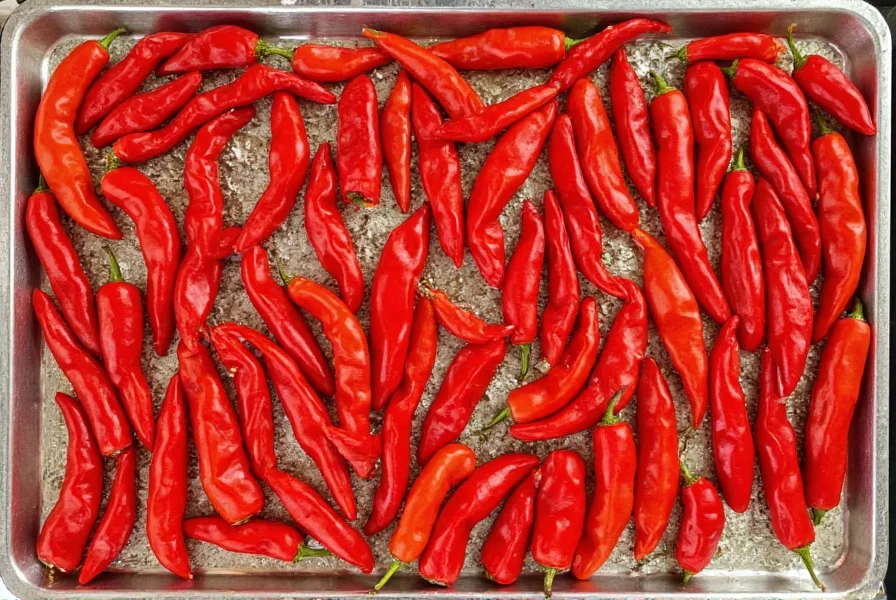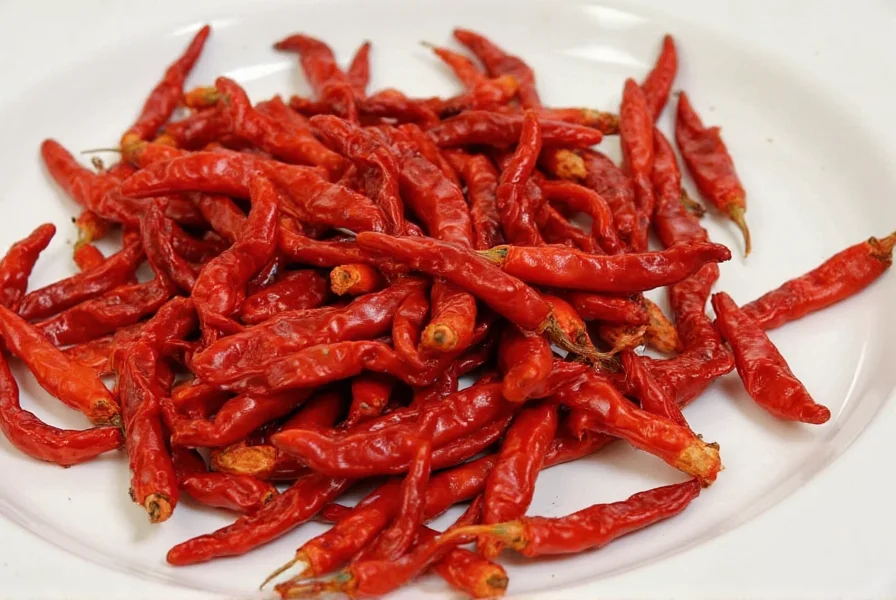Drying chili peppers preserves their intense flavor while concentrating heat and complexity. This traditional preservation method transforms fresh peppers into versatile ingredients perfect for grinding into powder, creating flakes, or using whole in cooking. Whether you've harvested your garden bounty or found a great deal at the market, drying extends shelf life while maintaining nutritional value better than freezing.
Preparing Chili Peppers for Drying
Proper preparation ensures optimal drying results and food safety. Start with fresh, firm peppers free from blemishes or soft spots. Wash thoroughly under cool running water, then pat completely dry with clean towels. Wear gloves when handling hot varieties like habaneros or ghost peppers to prevent skin irritation.
Decide whether to dry peppers whole or sliced. Whole peppers take longer but maintain shape better, while sliced peppers dry faster. For sliced peppers, cut lengthwise to expose more surface area while preserving seeds (which contain much of the heat). Remove stems but keep seeds attached for maximum flavor retention.
| Drying Method | Temperature | Time Required | Best For |
|---|---|---|---|
| Food Dehydrator | 125-135°F (52-57°C) | 12-24 hours | All pepper types, especially large batches |
| Oven Drying | 140-170°F (60-77°C) | 6-12 hours | Small batches when dehydrator unavailable |
| Air Drying | Room temperature | 2-3 weeks | Mild climates with low humidity |
| Sun Drying | Natural sunlight | 3-7 days | Hot, dry climates with low humidity |
Step-by-Step Drying Methods
Using a Food Dehydrator (Recommended Method)
A food dehydrator provides the most consistent results for drying chili peppers at home. Arrange prepared peppers in a single layer on dehydrator trays, ensuring space between pieces for air circulation. Set temperature to 135°F (57°C) and dry for 12-24 hours, checking periodically after the 12-hour mark. Rotate trays occasionally for even drying. The process is complete when peppers snap easily rather than bend.

Oven Drying Technique
For those without a dehydrator, oven drying offers a reliable alternative. Preheat your oven to its lowest setting (ideally 140-170°F/60-77°C). Place prepared peppers on wire racks over baking sheets to allow air circulation. Prop the oven door slightly open with a wooden spoon to maintain proper airflow and prevent moisture buildup. Check every 2 hours, rotating pans as needed. Total drying time typically ranges from 6-12 hours depending on pepper thickness and oven consistency.
Air Drying Method
Air drying requires patience but no special equipment. Thread whole peppers onto kitchen string through the stem end, leaving space between peppers. Hang in a warm, dark, well-ventilated area away from direct sunlight. A pantry or closet works well. Ensure good air circulation around the string. In ideal conditions (70°F/21°C with 60% humidity), peppers should dry completely in 2-3 weeks. Check weekly for mold, especially in humid environments.
Sun Drying Process
Sun drying works best in hot, dry climates with low humidity. Place prepared peppers on mesh screens elevated off the ground. Cover with cheesecloth to protect from insects while allowing airflow. Bring indoors at night or during rain. Turn peppers daily for even drying. Complete drying typically takes 3-7 days in optimal conditions (90°F/32°C with low humidity). This method requires careful monitoring to prevent spoilage.
Determining When Peppers Are Properly Dried
Proper dryness is crucial for successful preservation. Test peppers by bending them—fully dried peppers should snap crisply rather than bend or feel leathery. They should have no visible moisture and feel lightweight. For whole peppers, shake gently; you should hear seeds rattling inside. If any part feels pliable or shows signs of moisture, continue drying. Under-dried peppers risk mold during storage, while over-dried peppers may become brittle and lose flavor.
Storing Dried Chili Peppers
Proper storage maintains quality and extends shelf life. Allow dried peppers to cool completely before storing. Place in airtight glass jars or vacuum-sealed bags, removing as much air as possible. Store in a cool, dark place away from heat sources. For maximum longevity, include a food-safe desiccant packet to absorb any residual moisture. Properly stored dried peppers maintain optimal flavor for 6-12 months, though they remain safe to eat beyond this timeframe with gradually diminishing quality.
Using Your Dried Chili Peppers
Dried peppers offer versatile culinary applications. Rehydrate by soaking in hot water for 15-20 minutes before using in sauces or stews. For chili powder, grind completely dry peppers in a dedicated spice grinder until fine. Create flakes by breaking dried peppers into small pieces, optionally removing seeds for milder heat. Whole dried peppers add depth to soups, stews, and braises. Remember that dried peppers are significantly more concentrated in heat than fresh—start with smaller amounts and adjust to taste.
Troubleshooting Common Drying Issues
Mold development indicates insufficient drying or high humidity. Discard affected peppers immediately. If peppers dry unevenly, rotate trays more frequently during the process. Peppers that become overly brittle may have been dried at too high a temperature. In humid environments, consider using a dehumidifier in the drying area or adding extra drying time. For best results, dry peppers in small batches rather than overcrowding the drying space.
Frequently Asked Questions
Can you dry chili peppers in the microwave?
While technically possible, microwave drying isn't recommended for chili peppers. The uneven heating often cooks rather than dries peppers, resulting in inconsistent texture and potential burning. Microwave drying also fails to remove moisture thoroughly, increasing mold risk during storage. Traditional methods like dehydrators or oven drying provide better control and more reliable results.
Do dried chili peppers get hotter over time?
Dried chili peppers don't actually become hotter as they age, but the perception of increased heat can occur as moisture evaporates during storage. The capsaicin concentration remains constant, but with less water content, the same amount of pepper delivers more capsaicin per bite. Properly stored dried peppers maintain consistent heat levels for 6-12 months before gradually diminishing in potency.
Should I remove seeds before drying chili peppers?
Leaving seeds attached during drying preserves maximum flavor and heat, as capsaicin concentrates in the white pith surrounding seeds. Remove seeds only if you prefer milder results. If keeping seeds, ensure they remain attached to the pepper flesh during preparation, as loose seeds can fall off during drying. You can always remove seeds after drying when preparing peppers for specific recipes.
How do I know if my dried chili peppers have gone bad?
Signs of spoiled dried chili peppers include visible mold (white, green, or black spots), musty odors, or soft, leathery texture instead of crisp brittleness. Properly dried peppers should snap cleanly when bent. If peppers show any moisture or flexibility after proper storage, they've likely absorbed humidity and should be discarded. Always inspect dried peppers before use, especially if stored beyond 12 months.
What's the best way to grind dried chili peppers?
For the finest powder, use a dedicated spice grinder or high-powered blender after ensuring peppers are completely dry. Pulse in short bursts to prevent overheating, which can degrade flavor. Allow ground pepper to cool completely before storing. For coarser flakes, simply break dried peppers by hand or use a food processor with quick pulses. Always wear a mask when grinding to avoid inhaling capsaicin particles, and clean equipment thoroughly afterward.











 浙公网安备
33010002000092号
浙公网安备
33010002000092号 浙B2-20120091-4
浙B2-20120091-4